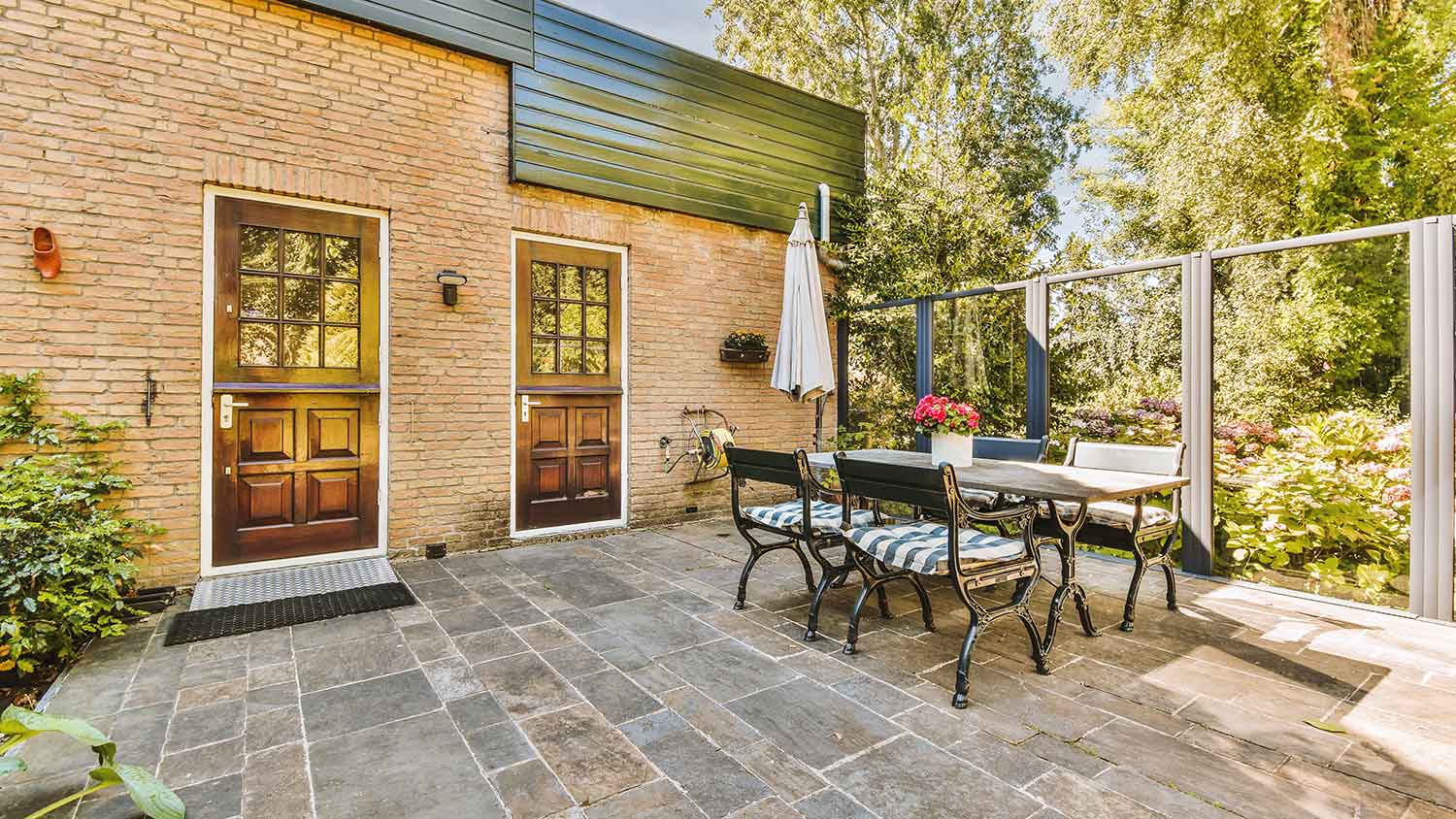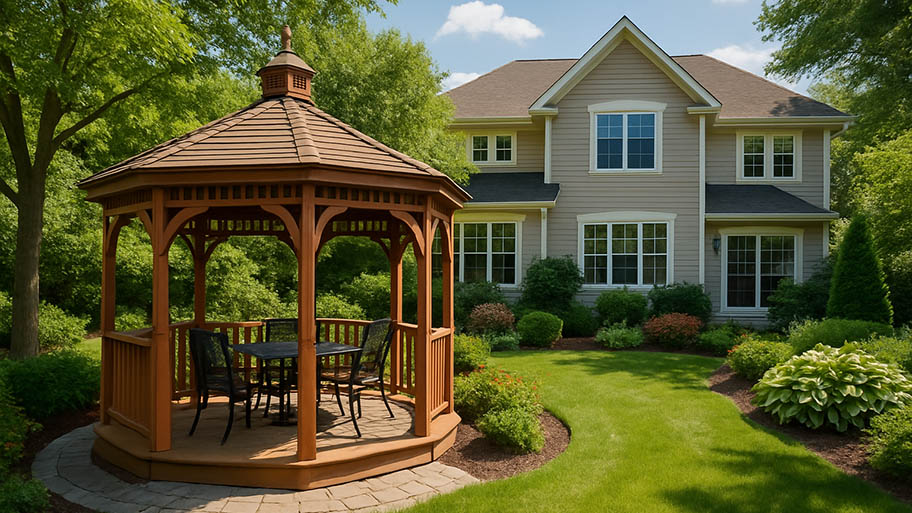
A deck skirt can improve the form and function of a deck. Find out what it could cost to install deck skirting in your backyard with this guide.
Porches are typically attached to the home, while patios are freestanding structures


Porches are usually attached to the front of the home.
Patios are freestanding structures typically in the backyard.
Porches are typically more expensive and difficult to maintain than patios.
Patios offer a larger, more open space for entertaining.
Nothing beats having a relaxing outdoor space for morning coffees, weekend gatherings, and afternoon lounges. If you’ve been considering adding one of your own, you’ve likely wondered about the difference between a patio vs. porch. While the two terms are often used interchangeably, these two structures aren’t quite the same. Let’s dive into a comparison of patios and porches to help you choose the right one for your home.
Patios and porches might sound like they’re one and the same, but there are a few distinguishing characteristics between the two.
Porches: These structures are usually covered by a roof and attached to the front of the home. Porches often have more complex, enclosed designs with railings and other intricate features.
Patios: Patios are freestanding structures in a separate area in the backyard. Also, patios tend to have a more open feel with minimal surrounding structures.

A porch is a beautiful way to adorn a home’s facade and add more living space, but it can be a major project to undertake. Still, when weighing the pros and cons, it offers a great vibe and aesthetic.
A porch provides a relaxing, sheltered outdoor space that’s a step beyond your door—a major plus for watching rain storms, especially if you have a screened-in porch. Plus, if you have outdoor furniture, the porch’s roof can help preserve your pieces and protect them from the elements. In addition, a well-maintained porch can add serious curb appeal to your home, which comes in handy when you’re ready to sell your house.
Since porches typically have more complex designs, building a porch is usually more expensive and difficult than installing a patio. Another main drawback to having a porch is that its usability is somewhat limited. For example, since these are attached to your home, they’re not a safe space for a fire pit or outdoor fireplace. Plus, they’re not typically practical or wide enough for large gatherings.
A patio is a great choice for those seeking an outdoor living space that is more secluded and private than a porch. Let’s review its pros and cons.
One of the greatest benefits of having a patio is it requires less maintenance than decks and porches. However, you still need to sweep them regularly, power wash annually, and maintain your pavers. And in comparison to decks, patios are much easier and less expensive to install.
Since patios are detached from the home and typically built in the backyard, there are no worries about passersby viewing your private lounging area. Patios are also perfect for entertaining guests, as you can easily set up tables and chairs, a picnic spread, a movie projector, and anything else you can dream up.
Shelter from inclement weather and outdoor pests isn’t a given with patios, limiting their use unless they’re covered with a roof, pergola, or similar structure. Patios also tend to accumulate dirt faster due to their proximity to the ground, so they’ll likely need to be swept or washed more often than a porch.

Debating whether to get a patio or a porch to enhance your outdoor space? Here’s a look at how these two structures compare.
It’s hard to match the “wow” factor of an attached porch, especially when it’s intricately designed with stairs and railings for extra-dramatic effect. While a concrete slab or paver patio is typically more focused on functionality, there are tons of options for building gardens or lavish outdoor living spaces around it.
Better appearance: Tie
When comparing a patio vs. porch, a patio offers the most options for customization by far. You can install a firepit, plant a lush garden, add an outdoor bar or kitchen, and so much more. Building a porch provides the option to choose a sunroom or enclosed porch, along with a number of other structural customizations, but it’s typically too narrow for more elaborate setups.
Most customizable: Patio
Since patios are freestanding structures built directly on the ground, they’re typically more durable than porches. The elevated design of a porch means more stress on the building materials, so it’s possible to have collapsing floorboards, broken railings, and similar issues over time. Still, this doesn’t mean that a patio is the end-all, be-all of durability. Concrete slabs are prone to cracking, and pavers can drift or settle if they’re not properly installed. In either case, proper design and installation are key.
More durable: Tie
In terms of price, a patio will almost always cost less to build (excluding add-ons, of course). The cost to build a patio is between $1,940 and $5,700, while building a screened-in porch costs $4,600 to $22,000 on average.
Most budget-friendly: Patio
It’s possible to build a front porch on your own, but it’s a major undertaking. Building a porch is an advanced-level project that will most likely require the expertise of a local deck builder. Since these structures are elevated and attached to the home, they must be carefully designed and built to ensure they are safe and structurally sound. On the other hand, building a DIY patio is much more approachable and forgivable since it’s flush with the ground and detached from the home.
Easier to install/DIY: Patio
In most cases, a backyard patio will offer the most privacy, as it will be out of the view of public streets and sidewalks. However, it can vary based on the size and setup of your lot. For example, a small backyard patio surrounded by neighbors might not offer as much privacy as a front porch that has a large front yard to buffer it from public view.
More privacy: Patio
Due to the simplicity of its design, a patio generally needs very little maintenance aside from the regular cleanings and annual power washing. On the other hand, a porch may feature wooden boards that need regular cleaning and sealing to prevent cracking, warping, or rotting. Also, since a porch has more structural components, you’re more likely to run into the occasional cracked floorboard or loose railing.
Easier to maintain: Patio
From average costs to expert advice, get all the answers you need to get your job done.

A deck skirt can improve the form and function of a deck. Find out what it could cost to install deck skirting in your backyard with this guide.

The average gazebo installation cost depends on the size and material. Keep reading to discover how much your gazebo may cost.

A concrete patio adds valuable outdoor living space to your home. Learn how much a concrete patio costs and which factors affect the project price.

If you’re looking to build a deck with minimal harm to the environment, consider using one of these five sustainable decking materials.

Sunken pavers can cause trip hazards and drainage issues, but in many cases, you can fix them yourself. This guide walks you through how to fix sunken pavers using basic tools and materials.

Before you pour your concrete, you should know how thick a concrete patio should be. The ideal thickness varies, so use this guide to get it right.